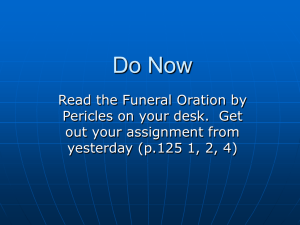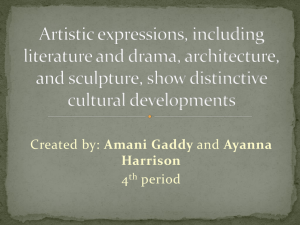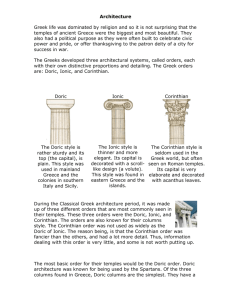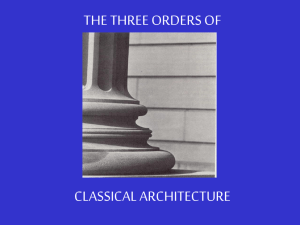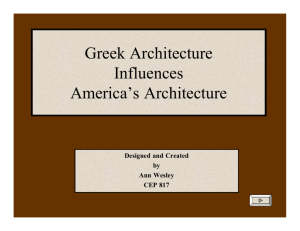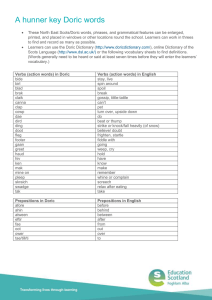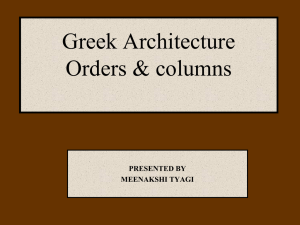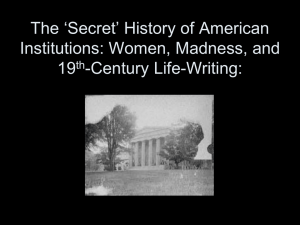Test 01
advertisement
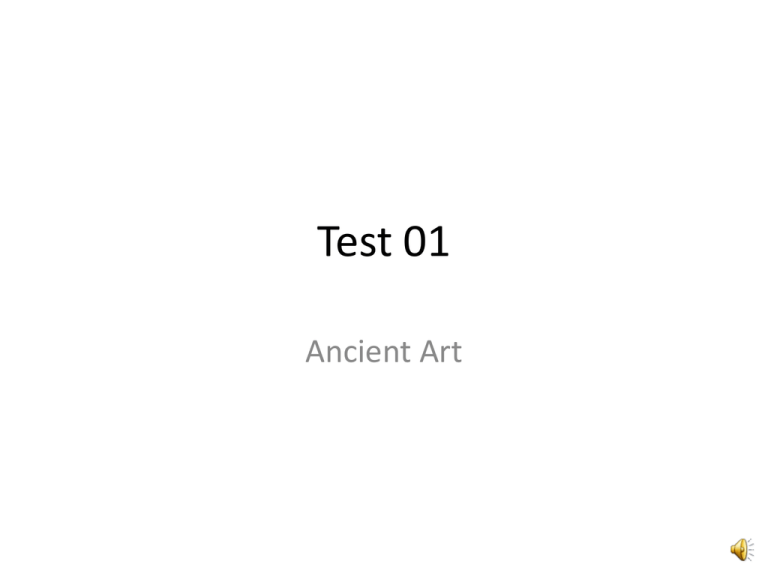
Test 01 Ancient Art Test 01 1. What type of column is this? a. Doric b. Corinthian c. Ionic d. Classical Test 01 2. What type of column is this? a. Ionic b. Corinthian c. Hellenistic d. Doric Test 01 3. What type of column is this? a. Doric b. Corinthian c. Ionic d. Archaic 4. What is the progression in time for the columns? a. Ionic, Corinthian, Doric b. Doric, Ionic, Corinthian c. Corinthian, Doric, Ionic d. Ionic, Doric, Corinthian Test 01 5. a. b. 6. a. b. 7. a. b. Corinthian columns are the least constructed. True False Ionic columns at times have figures on them. True False Doric columns have the simplest capitols. True False Test 01 8. What is the title of this piece? a. The dying Gaul b. Discus thrower c. Spear bearer d. Kridian boy 9. What period is it from? a. Archaic b. Hellenistic c. Doric d. Classical Test 01 10. What is the title of this piece? a. The dying Gaul b. Discus thrower c. Spear bearer d. Kridian boy 11. What period is it from? a. Archaic b. Hellenistic c. Doric d. Classical 12. Who was the artist? a. Polyclitus b. Myron 13. This is an example of contrapposto. a. True b. False Test 01 14. What is the title of this piece? a. The dying Gaul b. Kouros c. Spear bearer d. Kridian boy 15. What period is it from? a. Archaic b. Hellenistic c. Doric d. Classical 16. The Ancient Greeks showed the Egyptians how to create large statues. a. True b. False Test 01 17. What is the title of this piece? a. The dying Gaul b. Discus thrower c. Spear bearer d. Kridian boy 18. What period is it from? a. Archaic b. Hellenistic c. Doric d. Classical 19. Who is the artist? a. Polyclitus b. Myron Test 01 20. What is the title of this piece? a. The dying Gaul b. Discus thrower c. Spear bearer d. Laocoön and his Sons 21. What period is it from? a. Archaic b. Hellenistic c. Doric d. Classical 22. The creative explosion started about 30,000 years ago. a. True b. False Test 01 23. This is the Venus von Willendorf. a. True b. False 24. Why did prehistoric artist create images like this of humans? a. Society b. Instinct c. Both a and b 25. There are several Venus’s like this one around the world. a. True b. False Test 01 26. Egypt was built on agriculture. a. True b. False 27. Egyptian figures are designed using a grid. a. True b. False 28. Egyptian artists changed the image of the figure several times through history. a. True b. False 29. Egyptian figures are based on instinct. a. True b. False 30. Karnack demonstrates the history of Egyptians Pharaohs. a. True b. False Test 01 31. What where the first Greek statues called? a. Idols b. Classical c. Hellenistic d. Archaic 32. The Greeks where body obsessed. a. True b. False 33. The Egyptian’s altered the human figure how? a. Eyes where front view b. Hands where both right handed c. Legs where side view d. All of the above 34. Polyclitus was the first artist to use contrapposto. a. True b. False Test 01 35. The Greeks created figures based off of? a. Society b. Instinct c. Both a and b d. None of the above 36. The Greeks worshipped several Gods. a. True b. False 37. Men where held in higher regard then women. a. True b. False 38. The Riachie Bronzes exaggerated the human figure. a. True b. False Test 01 39. This is the first statue to depict a realistic human figure. a. True b. False 40. What is the title of this piece? a. Kridian boy b. Kouros c. Archaic d. Classical 41. The Ancient Greeks created pieces like these of two generations. a. True b. False 42. Why did the Greeks stop creating statues like these? a. To realistic b. Boring c. No action d. All of the above Test 01 43. The figure on the left is Poseidon and the figure on the right is Zeus. a. True b. False 44. These are the Richie Bronzes. a. True b. False 45. They are very realistic and in proportion. a. True b. False Test 01 46. Doric 47. Ionic 48. Corinthian 49. Contrapposto 50. Creative explosion a. b. c. d. e. had an elaborate base and the capital carved into double scrolls that looked like the horns of a ram the principle feature is a simple, heavy column without a base, topped by a broad, plain capital the capital is elongated and decorated with leaves or figures a pose in which the weight of the figure is balanced on one leg while the other is free and relaxed happened about 30,000 years ago and was the start of what is concerned the beginning of art
